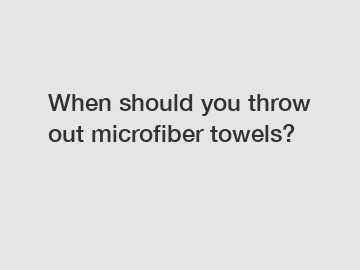When should you throw out microfiber towels?
When should you throw out microfiber towels?
Microfiber towels have become increasingly popular in recent years due to their superior cleanliness and durability. These highly absorbent and lint-free towels have revolutionized the cleaning industry, replacing traditional cotton towels in many households and professional settings. However, like all things, microfiber towels have a lifespan, and knowing when to throw them out is crucial for maintaining their effectiveness and preventing the spread of bacteria. In this article, we will explore the signs that indicate it's time to part ways with your beloved microfiber towels.
Point 1: Wear and Tear.

Microfiber towels, despite their durability, will eventually start showing signs of wear and tear. Examine your towels closely and look for any fraying or loose fibers. If the edges are becoming frayed or you notice any threads sticking out, it's a clear indication that the towel has reached its limit. These damaged fibers can be abrasive and potentially scratch sensitive surfaces during cleaning.
Point 2: Loss of Absorbency.
One of the main reasons we use microfiber towels is their exceptional absorbency. Over time, however, these towels may lose their ability to absorb liquids efficiently. If you notice that your towels seem to be pushing around liquid rather than soaking it up, it's a sign that the fibers have become clogged or coated with residues. Washing them thoroughly doesn't help restore their absorbency, and it's time to replace them.
Point 3: Foul Odor.
Microfiber towels can harbor bacteria if not cleaned properly. As they reach the end of their lifespan, it becomes harder to eliminate the odor-causing bacteria even with regular washing. If your towels consistently have a foul smell even after washing, it's a clear indication that it's time to discard them. Using towels with lingering bacteria can lead to cross-contamination, defeating the purpose of cleaning and posing potential health risks.
Point 4: Reduced Cleaning Performance.
Microfiber towels are known for their exceptional cleaning performance, easily capturing and trapping dirt and debris. As they age, however, these towels may no longer be as effective in picking up particles. If you notice that your towels are leaving streaks or smudges behind during cleaning or aren't capturing dust and dirt like they used to, it's time to invest in new ones. Continuing to use ineffective towels will only prolong the cleaning process and compromise the quality of your results.
In conclusion, knowing when to throw out microfiber towels is essential for maintaining optimal cleaning performance and preventing the spread of bacteria. Signs such as wear and tear, loss of absorbency, foul odor, and reduced cleaning performance indicate that it's time to replace your towels. Regularly inspecting and evaluating your microfiber towels' condition will help you determine when they have reached the end of their lifespan.
Remember, microfiber towels are an investment in cleanliness, and using worn-out towels can do more harm than good. By replacing them promptly, you ensure that your cleaning routine remains efficient and effective, providing a clean and germ-free environment for you and your family. So, the next time you notice any of these signs, don't hesitate to bid farewell to your trusted microfiber towels and welcome a fresh set into your cleaning arsenal.
Are you interested in learning more about microfiber mop stripe, china a microfiber cloth manufacturer, microfibre floor mat? Contact us today to secure an expert consultation!


